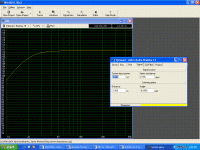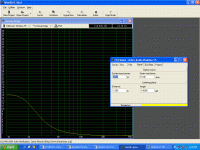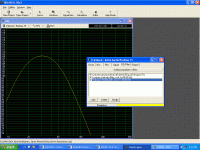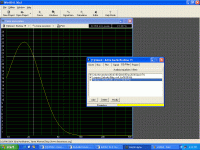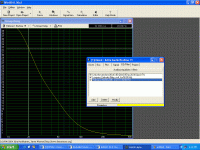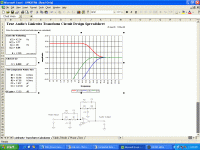I have a Brahma 15 MKI that I plan I using in a sealed box with a Linkwitz Transform. This is the first time I have used a Linkwitz transform, and I wanted to see what you guys think of the design.
The box is 60 liters. Attached is the WinISD model of the SPL with 250W. Above 250W I reach max excursion.
The box is 60 liters. Attached is the WinISD model of the SPL with 250W. Above 250W I reach max excursion.
Attachments
One thing that bothers me is the group delay when I apply all the filters. WinISD predicts 32.8m/s at 20Hz. I plan on running on my filters actively, but my understanding is that the phase shift will cause group delay even when using active filters. Is this correct? Any suggestions?
yes group delay is related to phase shift😉
Dont worry about phase graphs,not many people can even interpret them.
Worry instead about how to integrate it with your room!
Also,regarding power input,your amplifier must be capable of providing the power demanded by the EQ. So if 250w input is correct,if your amplifier can handle the ~9dB EQ you may have applied [2000w]
www.sound.westhost.com describes it.
Dont worry about phase graphs,not many people can even interpret them.
Worry instead about how to integrate it with your room!
Also,regarding power input,your amplifier must be capable of providing the power demanded by the EQ. So if 250w input is correct,if your amplifier can handle the ~9dB EQ you may have applied [2000w]
www.sound.westhost.com describes it.
Thanks mike.e,
What is interesting is that the phase response calculated by True Audio's page looks much different than WinISD's...or maybe I am one of those who can't interpret phase graphs, which is quite possible 🙂 .
I have a BK Electronics OMP1000 (http://www.bkelec.com/Diy/mf1000.html) that delivers 1050W into a 2ohm load. It is currently powering a 1ohm load and seems to be holding its own, but I don't know what kind of power it is putting out.
True Audio's spreadsheet calculates a 12-13dB gain at 20Hz (see attachment). Ouch. However, Rod Elliot's page implies (as I read it) that the amp will not be required to crank the full EQ power RMS as much of the signal demands appear as transients and much of the low bass in music occurs at a lower volume. Unfortunately, he doesn't expand on this as far as I can tell, so it has left the actual power requirements as a bit of a mystery to me.
Also, I plan to use this sub strictly for music, as I have a ported Brahma 12 that I use for home theater. The Brahma 12 models a group delay that climbs steeply into the upper 30's m/s at 20Hz. I wanted to build this sub partly to compare a low group delay sub to the relatively high group delay of the Brahma 12. That is why I was so concerned about the GP and phase shift.
Do you have some tips on integrating the sub into the room?
What is interesting is that the phase response calculated by True Audio's page looks much different than WinISD's...or maybe I am one of those who can't interpret phase graphs, which is quite possible 🙂 .
I have a BK Electronics OMP1000 (http://www.bkelec.com/Diy/mf1000.html) that delivers 1050W into a 2ohm load. It is currently powering a 1ohm load and seems to be holding its own, but I don't know what kind of power it is putting out.
True Audio's spreadsheet calculates a 12-13dB gain at 20Hz (see attachment). Ouch. However, Rod Elliot's page implies (as I read it) that the amp will not be required to crank the full EQ power RMS as much of the signal demands appear as transients and much of the low bass in music occurs at a lower volume. Unfortunately, he doesn't expand on this as far as I can tell, so it has left the actual power requirements as a bit of a mystery to me.
Also, I plan to use this sub strictly for music, as I have a ported Brahma 12 that I use for home theater. The Brahma 12 models a group delay that climbs steeply into the upper 30's m/s at 20Hz. I wanted to build this sub partly to compare a low group delay sub to the relatively high group delay of the Brahma 12. That is why I was so concerned about the GP and phase shift.
Do you have some tips on integrating the sub into the room?
Attachments
mike.e said:Also,regarding power input,your amplifier must be capable of providing the power demanded by the EQ. So if 250w input is correct,if your amplifier can handle the ~9dB EQ you may have applied [2000w]
I read the whole article and didn't see it, can you point us a bit better?
He's using 250W and the Linkwitz Transform is before the amplifier so if he's using 250W of amplification, he's using 250W, not 2000W...

i dont know wtf you did in your WinISD but in my WinISD you dont reach 28mm one way untill 2000w in a 60l box....even if you forgot to hit one of the 0's, ie 600l box (HUGE) untill a 500w input and you only reach that at 10Hz..... at 20 you need 800w...but then agian WinISD is Ghey.....

Hi CBFryman,
Did you apply the Linkwitz transform EQ (20Hz) to your model? The excursion peaks with a lot less power given the huge amounts of EQ at low frequencies.
Did you apply the Linkwitz transform EQ (20Hz) to your model? The excursion peaks with a lot less power given the huge amounts of EQ at low frequencies.
The TrueRTA spreadsheet doesn't predict a phase curve. The 3 curves are the natural FR, the EQ curve and the FR after EQ is applied to the signal.
I would not use a HP filter in a sealed design...defeats the purpose of choosing a sealed alignment for it's low GD. The Brahma 15 in 2 cubes won't require protection.
If your L/T boost is 12 dB @ 20 Hz, then at max SPL (about 108 dB @ 1 meter), you'll require 250 watts X 16 (12 dB=16 times), or 2,000 watts to maintain a flat response to 20 Hz.
That's per the computer model, which is only a model.
If the sub is strictly for music, a low 'B' tuned 5 string bass will play just above 30 Hz, so most any music you play through the sub will be easily handled. There will rarely be much content at or below 20 Hz.
Still, if you crank the system and there is content at and below 20 Hz, I think your available amp power will be the problem, not the Brahma reaching Max Excursion.
A Brahma 15 in 2 cubes with 12 dB of L/T boost (and final 'Q' of .5) is an excellent music sub design. I have a couple of them around here and I power them with around 1,400 available watts each. Seems to be a good power plant for the design.
I've never bottomed either of them in this config, but I do have amp clip indicators and have seen clipping in some instances.
The 1KW amp you have will be fine. If you feel the need to push the design to it's limits, you can try a larger amp. I think up to 2KW would be fine in most cases.
Another helpful hint in this design is to take every precaution to eliminate air leaks which will sound like $hit and change the excursion limits. Check for them using a 20 Hz sine wave tone, find them and seal them.
All of the above is just from experience with modeling, building and graphing 1X15 and 2X15 sealed, L/T Brahmas in various sizes of box and with various high powered amps and my humble opinion.
Bosso
I would not use a HP filter in a sealed design...defeats the purpose of choosing a sealed alignment for it's low GD. The Brahma 15 in 2 cubes won't require protection.
If your L/T boost is 12 dB @ 20 Hz, then at max SPL (about 108 dB @ 1 meter), you'll require 250 watts X 16 (12 dB=16 times), or 2,000 watts to maintain a flat response to 20 Hz.
That's per the computer model, which is only a model.
If the sub is strictly for music, a low 'B' tuned 5 string bass will play just above 30 Hz, so most any music you play through the sub will be easily handled. There will rarely be much content at or below 20 Hz.
Still, if you crank the system and there is content at and below 20 Hz, I think your available amp power will be the problem, not the Brahma reaching Max Excursion.
A Brahma 15 in 2 cubes with 12 dB of L/T boost (and final 'Q' of .5) is an excellent music sub design. I have a couple of them around here and I power them with around 1,400 available watts each. Seems to be a good power plant for the design.
I've never bottomed either of them in this config, but I do have amp clip indicators and have seen clipping in some instances.
The 1KW amp you have will be fine. If you feel the need to push the design to it's limits, you can try a larger amp. I think up to 2KW would be fine in most cases.
Another helpful hint in this design is to take every precaution to eliminate air leaks which will sound like $hit and change the excursion limits. Check for them using a 20 Hz sine wave tone, find them and seal them.
All of the above is just from experience with modeling, building and graphing 1X15 and 2X15 sealed, L/T Brahmas in various sizes of box and with various high powered amps and my humble opinion.
Bosso
Thanks bossobass,
My True Audio calculations were for a final system Q of .77, which I believe is the default for the spreadsheet. I see a final Q of .5 trades a bit of SPL (about 3dB) for lower group delay. I will give that a shot as well.
My True Audio calculations were for a final system Q of .77, which I believe is the default for the spreadsheet. I see a final Q of .5 trades a bit of SPL (about 3dB) for lower group delay. I will give that a shot as well.
Sorry to go off topic. You say your OMP1000 works into a 1ohm load? I was contemplating getting two and bridging them into a Tumult (1.6ohm load per amp).
"You say your OMP1000 works into a 1ohm load? I was contemplating getting two and bridging them into a Tumult (1.6ohm load per amp)."
Well, I haven't actually had it bench tested or anything. I sent BK an email asking about the possibility of driving a 1ohm load, and their advice was, "try it and see...start at a low volume." So, that is what I did. I haven't noticed any clipping, etc. so far, but I rarely get to really open it up. So I guess what I would say is that it works for me. I actually thought about running each VC with its own module, as BassAwdyO suggested.
The OMP1000 is a pretty burly unit, with big hardware. One modification you will want to make is to the fan. The one that came with my unit was hella noisy. I replaced it with some small, mag. levitation fans that I power from a wall wart. In my setup I can run the amp with the fans off for casual low level listening, but it is probably not the best idea.
Well, I haven't actually had it bench tested or anything. I sent BK an email asking about the possibility of driving a 1ohm load, and their advice was, "try it and see...start at a low volume." So, that is what I did. I haven't noticed any clipping, etc. so far, but I rarely get to really open it up. So I guess what I would say is that it works for me. I actually thought about running each VC with its own module, as BassAwdyO suggested.
The OMP1000 is a pretty burly unit, with big hardware. One modification you will want to make is to the fan. The one that came with my unit was hella noisy. I replaced it with some small, mag. levitation fans that I power from a wall wart. In my setup I can run the amp with the fans off for casual low level listening, but it is probably not the best idea.
BassAwdyO said:Matt, why bridge them? Dual 2ohm coils, and two 2ohm amps, one amp per coil!
Thats another possibility I suppose. I havent looked into it in great detail, not having cash for such a setup.

Raoul said:"You say your OMP1000 works into a 1ohm load? I was contemplating getting two and bridging them into a Tumult (1.6ohm load per amp)."
Well, I haven't actually had it bench tested or anything. I sent BK an email asking about the possibility of driving a 1ohm load, and their advice was, "try it and see...start at a low volume." So, that is what I did. I haven't noticed any clipping, etc. so far, but I rarely get to really open it up. So I guess what I would say is that it works for me. I actually thought about running each VC with its own module, as BassAwdyO suggested.
The OMP1000 is a pretty burly unit, with big hardware. One modification you will want to make is to the fan. The one that came with my unit was hella noisy. I replaced it with some small, mag. levitation fans that I power from a wall wart. In my setup I can run the amp with the fans off for casual low level listening, but it is probably not the best idea.
If it didnt overheat or blow up when you tried a 1 ohm load, thats tested enough for me. 😀
- Status
- Not open for further replies.
- Home
- Loudspeakers
- Subwoofers
- Brahma 15 Linkwitz Transform Check
